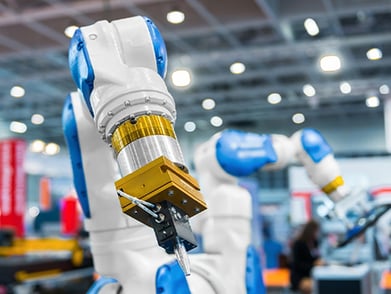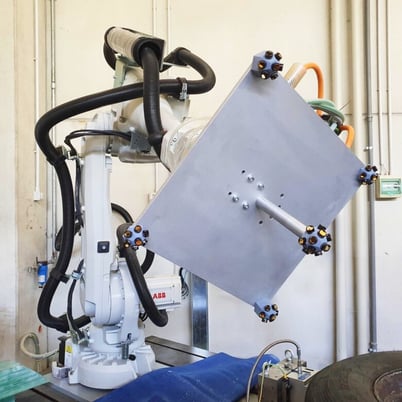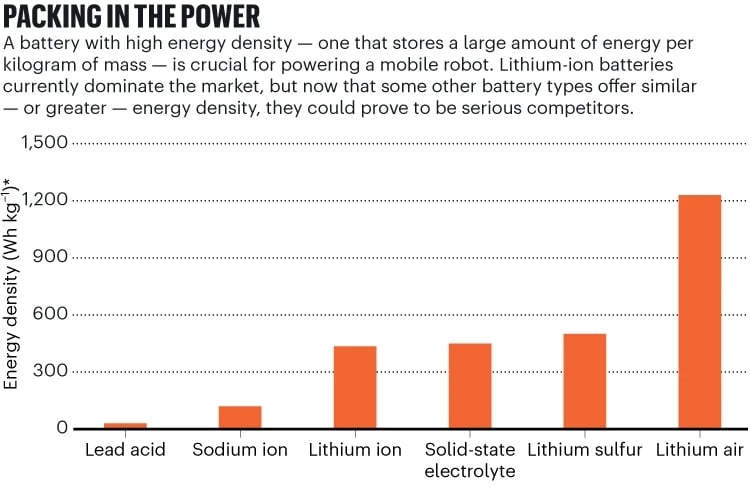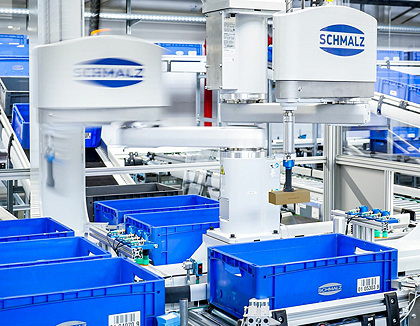What’s New in Robotics? 07.07.2023

Posted on Jul 07, 2023 7:30 AM. 9 min read time
News briefs for the week take a look at RoboCat and the dawning of the age of general-purpose robots, then the 10-fold productivity increase from Lockheed’s “smart” drilling robot, then here’s why robots need better batteries, followed by the world’s bin-picking champ at 2700 picks per hour, and finally, Comau also jumping into bin-picking sweepstakes with its super-fast picking cell.
Here comes the age of general-purpose robots
Trying to get robots and cobots to quickly switch between multiple tasks has, until now, been a complex chore to pull off. Most robots today are special-purpose, in that they perform a single task well until needed to perform yet another task, at which time they require yet more programming.
A general-purpose robot, with the ability to effortlessly automate most any given task when needed, has long been elusive. However, Google’s new RoboCat may well be the breakthrough answer, offering up new levels of intelligence, plus flexible automation, increased productivity, and decreased cost. In short, a manufacturer's dream tool.
 Created by Google’s UK-based DeepMind subsidiary, RoboCat is a self-improving AI agent that “learns to operate different robotic arms — and take on different tasks — with as little as 100 examples, and it can create its own training data to help sharpen performance,” so says DeepMind. A spin-off agent will then have a robot practice the task over and over again, physically and virtually — on average, 10,000 times.
Created by Google’s UK-based DeepMind subsidiary, RoboCat is a self-improving AI agent that “learns to operate different robotic arms — and take on different tasks — with as little as 100 examples, and it can create its own training data to help sharpen performance,” so says DeepMind. A spin-off agent will then have a robot practice the task over and over again, physically and virtually — on average, 10,000 times.
The AI behind RoboCat is called Gato, which can process actions, images, and languages in both the real world and simulated environments. DeepMind fed Gato a training set filled with robotic arms doing hundreds of different tasks.
Ultimately, RoboCat’s library of general-purpose robot arm movements self-improves to “a dataset of millions of trajectories, from both real and simulated robotic arms, including self-generated data.” RoboCat can learn to operate a new robotic arm within a few hours.
“After observing 1000 human-controlled demonstrations, collected in just hours, RoboCat could direct a new arm dexterously enough to pick up gears successfully 86% of the time.”
Not perfect yet, but pretty darn good!
Real world of “smart” robots
What does a robot or cobot imbued with intelligence look like in the real world? They are known by their deeds. Early results are showing “smart” robots to be very remarkable in manufacturing, like the 10-fold productivity gain that Lockheed Martin just experienced.
 Lockheed Martin identified a use case to apply AI that focused on a typical robotics work cell used by its factory cobots: drilling holes.
Lockheed Martin identified a use case to apply AI that focused on a typical robotics work cell used by its factory cobots: drilling holes.
Could AI “empower a commercial cobot with greater intelligence and understanding of its body and the task it is about to execute while ensuring the required quality and tolerances are achieved?”
Xaba’s “synthetic brain” xCognition, which specializes in manufacturing, was employed in the production test. Xaba claims that it is the developer of the first AI-driven robotics and CNC machine controller. Unlike analytical AI used for predictive modeling, Xaba says that its industrial AI focuses on the physical world. It can model and drive a vehicle, a complex machining center, and more complex industrial applications.
 The test consisted of two phases:
The test consisted of two phases:
Phase 1: Assessing the cobot’s performance in maintaining accurate and consistent trajectory positioning with and without Xaba’s xCognition.
Phase 2: Performing a set of drilling tests on an aluminum test plate with specified positional tolerances.
The results: Based on the data collected xCognition improved the accuracy and consistency of the commercial cobot by a factor of 10 fold.
Lockheed Martin’s Matthew Galla, an aeronautics applications engineer, remarked: “The test with the xCognition controller allows us to rethink how we can accelerate innovation in manufacturing.”
Early on, as witnessed in the Lockheed test, the impact of AI in assisting manufacturing robots and cobots seems to be nothing short of stunning.
Better batteries for robots
A fire at an Ocado warehouse, begun by an automated mobile robot (AMR) recharging its battery, burned for three days, losing in the process 300,000 customer orders and 1100 robots for a total of $48 million in damages.
 The warehouse burned to the ground in the three-day blaze after a fault in a battery charging unit set fire to the plastic lid of one of the grocery-picking robots.
The warehouse burned to the ground in the three-day blaze after a fault in a battery charging unit set fire to the plastic lid of one of the grocery-picking robots.
Some reports alleged that robots were still moving when firefighters arrived, hindering their ability to control the blaze.
It wasn’t an isolated incident. Another battery-related fire started when three warehouse robots collided. Once ignited, a robot’s lithium-ion batteries are extremely difficult to extinguish. As AMRs proliferate in the accelerated pace of automating warehouses, the incidence of more such fire dangers becomes distinctly possible.
And warehouse fires are not the only problem plaguing a robot’s lithium-ion batteries nor are warehouses the only trouble spots.

A recent article in the journal Nature, Robots Need Better Batteries, cites the mobile robots—on wheels, treads, tracks, or on two or four legs—unable to tolerate massive batteries. Boston Dynamics sells a four-legged dog-size robot called Spot that weighs about 32 kg — one-eighth of which is batteries, which need recharging after only 90 minutes.
“Energy density is still quite far from the power we need for robotics,” says Ravinder Dahiya, an electrical engineer specializing in robotics at Boston’s Northeastern University.
Future forward, lithium-ion technology is aging rapidly, with “less and less room for improvement,” says Richard Schmuch, a chemist at Germany’s Fraunhofer Research Institution for Battery Cell Production. “Lithium itself is rare and expensive. The same is true for cobalt, another crucial element which can make up to 20% of the weight of the cathode in lithium-ion batteries for electric vehicles.”
Like lithium, sodium is an alkali metal, and the chemistry of the two is so similar that researchers have pursued sodium-ion batteries as a way around the problems with lithium-ion. Sodium in seawater and salt deposits is more easily harvested, which negates the supply-chain problems arising from the cost and scarcity of lithium.
China’s Contemporary Amperex Technology (CATL) in Ningde — the world’s leading manufacturer of lithium-ion batteries for electric vehicles — rolled out the first generation of its sodium-ion battery; and this April, Chery Automobile in Wuhu, China, announced plans to install CATL sodium-ion batteries in its cars.
Advocates of the sodium-ion battery say it offers the best prospects for preventing the potentially deadly fires seen with lithium batteries, as well as for improving energy density and reducing costs.
Better batteries for robots may be just around the corner.
Blitz picking at 2700 per hour
Schmalz, the German vacuum gripper developer, must have gotten a bit tired of seeing bin-picking cells operating at less of a picking speed than it deemed appropriate. So, it developed its own, and in the process, set a new speed record for bin picking. Call it blitz picking at 2700 picks per hour!
 Schmalz blitz picking bests closest rival Pickit (2100 per hour) by 600. Both are well beyond the average of a pick-and-place robot’s rate of 300 per hour.
Schmalz blitz picking bests closest rival Pickit (2100 per hour) by 600. Both are well beyond the average of a pick-and-place robot’s rate of 300 per hour.
With the average number of items in an e-commerce order slightly over three, the Schmalz picking champ betters Pickit by 200 orders per hour.
In collaboration with German integrator, Körber, Schmalz built its own piece-picking cell using a pair of SCARA robots (Körber built the conveyor system).
“The robots work simultaneously and can change their grippers within a second, depending on whether they are handling boxes, vials, or bags. Two 3D cameras inspect the box after each pick.
“Software analyses this input, calculates, and controls the next grip. Several gripping algorithms operate in parallel to achieve the best picking performance. The system uses five-axis grippers that can reach into all corners of a crate.”
Schmalz developed the pick accelerator “kit” that optimizes the interaction between grippers, robots, cameras, and picking software called the Schmalz Solution Kit.
Comau joins bin-picking hunt
 Milan-based automation and robot developer Comau has also joined the bin-picking race with its MI.RA Picker, which uses two high-resolution laser sensors and a central camera, combined with virtual simulation tools and predictive algorithms, to optimize path management and achieve collision-free trajectories.
Milan-based automation and robot developer Comau has also joined the bin-picking race with its MI.RA Picker, which uses two high-resolution laser sensors and a central camera, combined with virtual simulation tools and predictive algorithms, to optimize path management and achieve collision-free trajectories.
Interestingly, the MI.RA Picker can be used with any make of robot, bin or gripper to recognize, locate and grasp up to 40 randomly placed items every minute, which tallies up to 2400 picks per hour. That’s a speed the betters Pickit, yet still falls short of the Schmalz industry-leading picking kit at 2700 picks per hour.


Leave a comment